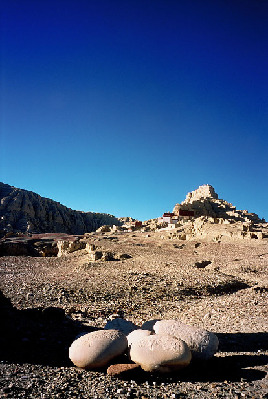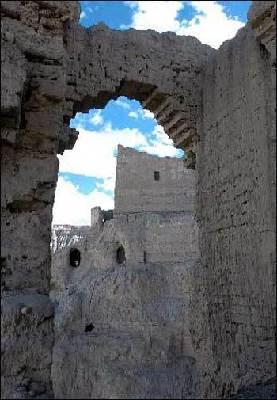| |

Within the territory of Zhada county, Ngari Prefecture, on the southern bank of the River Langchen Khabab (or Elephant Spring River, resembling an elephant drawing up water through its trunk), there lies a mound of yellow earth about three hundred meters in height. On this hill lie the ruins of a wall and a castle -- the most important remains of the ancient Guge Kingdom, well known throughout the world.
More than 1,000 years ago, a powerful kingdom with a splendid civilization was born here. But after more than 700 years of rule, the kingdom was destroyed overnight by internal disorder and invaders from the outside. What are left are the ruins of the capital of the Guge Kingdom.
The previously stylish caves are now seriously damaged. Few works of architecture remain intact. Although Guge, through its hardship in history, has lost its prosperity and graceful manner, its appearance is still imposing. It leaves a valuable history and numerous legends.
The ruins lie at a hilltop near a river, more than 300 meters high and covering 180,000 square meters. Houses, cave dwellings, monasteries, stupas, blockhouses, defense works and tunnels are distributed on the hill and surrounding area. Palaces sat on the summit while monasteries on mountainsides, and cave dwellings were located for common people at the foot of the hills. The kingdom was enclosed in tunnels and walls with fortifications. Some structures have survived and remain in good condition in this untraversed region though many of them were reduced into dust. A two-kilometer long water tunnel built with stones, in ruins, still dives from the summit into the river below, which used to be the principal water supply of the Guge people.
The only path from the base of the hill to the palace halls on the hilltop is a man-made tunnel. The upper part of the Guge Castle holds the Winter Hall and Summer Hall, where the royal family lived. They are empty now. Only the frescoes and wooden engravings in Tancheng Hall are well preserved.
Around the ruins, weapons of Guge people and mummies -- probably Guge soldiers -- have been discovered as a trace of the once glorious kingdom.
Guge Kingdom is now famous for its murals, sculptures and stone inscriptions, which are attached with those surviving structures. Among them, murals in the White Palace, Red Palace, Yamantaka Chapel, Tara Chapel and Mandala Chapel are preserved in good condition. The themes of those murals, hundreds of years old but still splendid, include mainly stories of Buddha, Sakyamuni, Songtsen Gampo, and kings of Guge and their ministers. A chapel on the summit of the hill houses a mural depicting male and female Buddhas finding Tantric cultivation together, while the lower part displays purgatory with naked, enchanting Dakinis flanking each side. The artistic and aesthetic value of Guge murals is deemed comparable with that of the Mogao Caves.
The wall of Guge is actually a library of stone inscriptions, which are as impressive as its murals. Mani stones are scattered around. Most sculptures of Guge style are gold and silver Buddhas.
Guge's colored paintings, frescoes and sculptures are rich works of a high artistic level and immense research value.

 History History
Guge is a miracle. For years it strongly attracted numerous explorers, scholars, artists and journalists who traveled from afar to investigate and search for treasures. According to historical records, after the last king of the Tubo Dynasty, Lang Darma, died, the royal family began to fight for the throne. Gyide Nyimagun, Long Darma's descendent, lost the war and ran away to Ngari, where he established a small kingdom. Later, Gyide Nyimagun divided Ngari into three parts and gave them to his three sons.
The Guge Kingdom was ruled by Dezogun, Gyide Nyimagun's third son. His regime ran for more than 700 years before being destroyed in a war. According to the Annals of Kings and Officials in Tibet, a total of 16 kings ruled the Guge Kingdom, and the Guge Castle was accomplished through constant construction between the 10th and 16th century.
Guge has a very significant position in the history of economic and cultural development of Tibet. Many significant Buddhist doctrines of ancient India were passed on to hinterland Tibet via Guge. Guge was also one of the important commercial ports linking ancient Tibet with the outside world. After the Tubo Dynasty died out, Tibet entered a 400-some year period of isolation, but Guge was always a large and powerful kingdom. Even the dust of time cannot hide its prosperity and past glory.
Best time to go: From July to August
|
|
